| Trypanisma | |
|---|---|
| Scientific classification | |
| Kingdom: | Animalia |
| Phylum: | Arthropoda |
| Class: | Insecta |
| Order: | Lepidoptera |
| Family: | Gelechiidae |
| Tribe: | Gelechiini |
| Genus: | Trypanisma Clemens, 1860 [1] |
Trypanisma is a genus of moths in the family Gelechiidae. [2]
| Trypanisma | |
|---|---|
| Scientific classification | |
| Kingdom: | Animalia |
| Phylum: | Arthropoda |
| Class: | Insecta |
| Order: | Lepidoptera |
| Family: | Gelechiidae |
| Tribe: | Gelechiini |
| Genus: | Trypanisma Clemens, 1860 [1] |
Trypanisma is a genus of moths in the family Gelechiidae. [2]

The genus Crambus includes around 155 species of moths in the family Crambidae, distributed globally. The adult stages are called crambid snout moths, while the larvae of Crambus and the related genus Herpetogramma are the sod webworms, which can damage grasses.

Parapoynx is a genus of moths of the family Crambidae described by Jacob Hübner in 1825.

Parornix is a genus of moths in the family Gracillariidae.
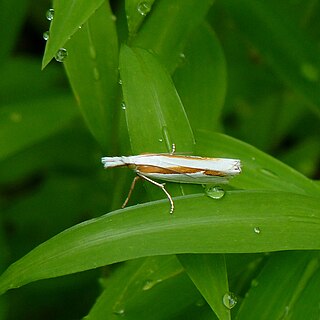
Crambus girardellus, or Girard's grass-veneer moth, is a moth in the family Crambidae described by James Brackenridge Clemens in 1860. It is found in North America, including Alberta, Ontario, Quebec, Labrador, Maine, New Hampshire, Massachusetts, New York, Pennsylvania, Maryland, Ohio and Michigan.

Aristotelia roseosuffusella, the pink-washed aristotelia, clover aristotelia moth or garden webworm, is a moth in the family Gelechiidae. It is found in North America, including Alabama, Georgia, Illinois, Kentucky, Maryland, Massachusetts, Michigan, New Jersey, Oklahoma, Ontario, South Carolina, Tennessee and Virginia. The species was first described by James Brackenridge Clemens in 1860.

Mompha is a genus of moths in the family Momphidae that was first described by Jacob Hübner in 1819. It has four subgenera.

Epipaschia is a genus of snout moths. It was described by James Brackenridge Clemens in 1860.
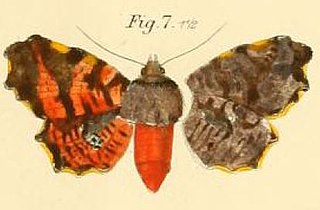
Dysodia is a genus of moths of the family Thyrididae. It was described by James Brackenridge Clemens in 1860.
Bucculatrix agnella is a species of moth in the family Bucculatricidae. The species was first described by James Brackenridge Clemens in 1860. It is found in North America, where it has been recorded in Pennsylvania, New Jersey, New York, Washington D.C., Massachusetts, Indiana, Tennessee, Kentucky, Michigan, Missouri, South Dakota, Maine, Ohio and Texas.

Parapoynx maculalis, the polymorphic pondweed moth, is a moth in the family Crambidae. It was described by James Brackenridge Clemens in 1860. It is found in eastern North America, where it has been recorded from Alabama, Alberta, Florida, Georgia, Illinois, Indiana, Louisiana, Maine, Maryland, Massachusetts, Michigan, Minnesota, Mississippi, New Brunswick, New Hampshire, New Jersey, Newfoundland, North Carolina, North Dakota, Nova Scotia, Ontario, Pennsylvania, Quebec, South Carolina, Tennessee, Texas and Wisconsin. The habitat consists of ponds and streams.

Argyria auratellus, the curve-lined vaxi or curve-lined argyria moth, is a moth in the family Crambidae. It was described by James Brackenridge Clemens in 1860. It is found in North America, where it has been recorded from the eastern United States and south-eastern Canada from Quebec and Maine to Florida, west to Texas and north to Manitoba. It is also found in California. The habitat consists of wet prairies and meadows.
Neodactria caliginosellus, the corn root webworm or black grass-veneer, is a moth in the family Crambidae. It was described by James Brackenridge Clemens in 1860. It is found in North America, where it has been recorded from Alabama, Alberta, California, Florida, Georgia, Illinois, Indiana, Maine, Maryland, Mississippi, North Carolina, Ohio, Oklahoma, Ontario, South Carolina and Tennessee. The habitat consists of grassy areas and fields.

Neodactria luteolellus, the mottled grass-veneer, is a moth in the family Crambidae. It was described by James Brackenridge Clemens in 1860. It is found in North America, where it has been recorded from Labrador and Quebec to North Carolina, west to Arizona and California and north to Alberta. The habitat consists of grassland areas in prairies, aspen parklands and boreal forests.
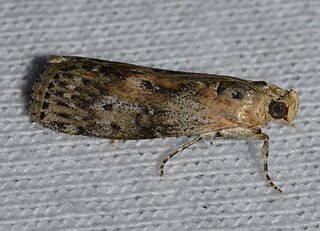
Sciota virgatella, the black-spotted leafroller moth, is a species of snout moth in the genus Sciota. It was described by James Brackenridge Clemens in 1860. It is found in North America, where it has been recorded from Arkansas, Florida, Georgia, Illinois, Indiana, Maine, Maryland, Massachusetts, Minnesota, New Jersey, New York, North Carolina, Ohio, Oklahoma, Ontario, Pennsylvania, Quebec, South Carolina, Tennessee, Texas, Virginia and West Virginia.
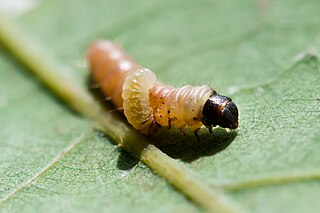
Psilocorsis is a genus of moths of the family Depressariidae.

Dichomeris juncidella is a moth in the family Gelechiidae. It was described by James Brackenridge Clemens in 1860. It is found in North America, where it has been recorded from Nova Scotia, southern Quebec and southern Ontario to Florida, Texas and Nebraska.
Trypanisma prudens is a moth of the family Gelechiidae. It was described by James Brackenridge Clemens in 1860. It is found in North America, where it has been recorded from Alabama, Arkansas, Florida, Illinois, Indiana, Kentucky, Louisiana, Maine, Michigan, Mississippi, Oklahoma, Pennsylvania, South Carolina and Tennessee.

Strobisia iridipennella, the iridescent strobisia moth, is a moth of the family Gelechiidae. It was described by James Brackenridge Clemens in 1860. It is found in North America, where it has been recorded from New York to Florida, west to Texas and Illinois, south to Mexico.
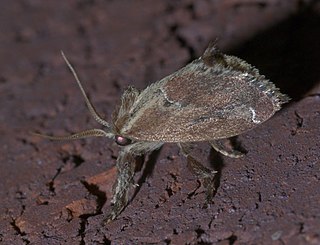
Adoneta is a genus of moths in the family Limacodidae. The genus was erected by James Brackenridge Clemens in 1860. There are at least four described species in Adoneta.
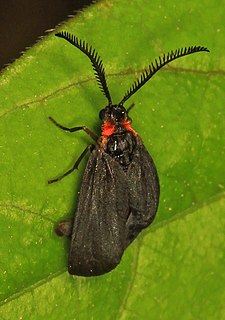
Acoloithus falsarius, or Clemens' false skeletonizer, is a moth species in the zygaenid subfamily Procridinae. The species occurs in North America and was described by James Brackenridge Clemens in 1860. A. falsarius has Hodges number 4629 and is the type species of genus Acoloithus.
| This article on a moth of the tribe Gelechiini is a stub. You can help Wikipedia by expanding it. |